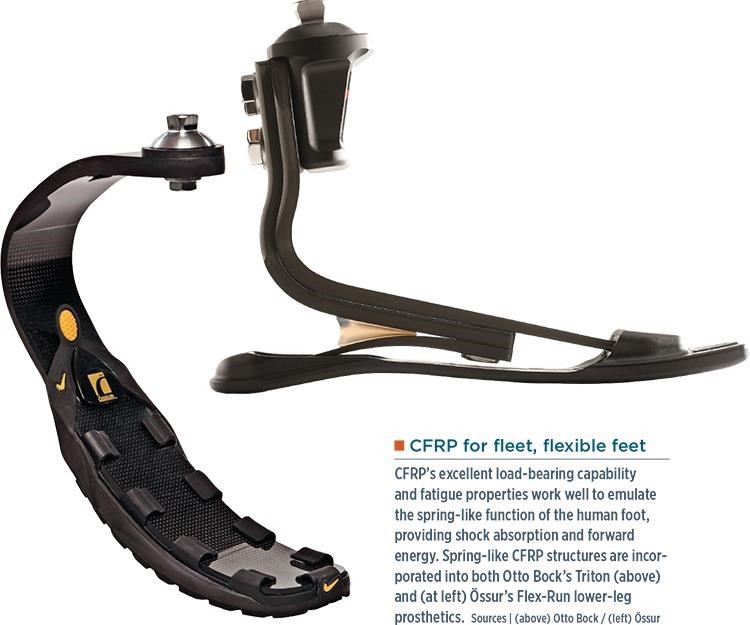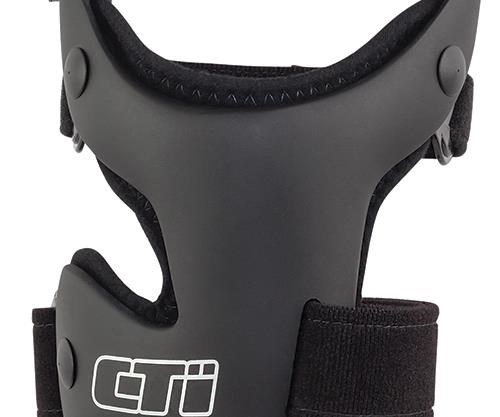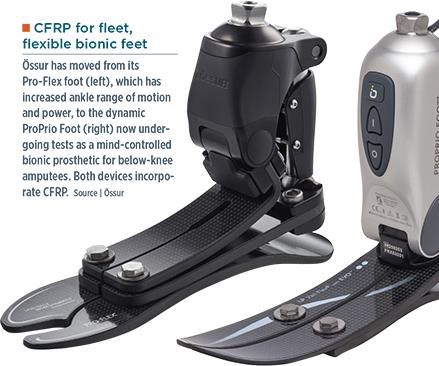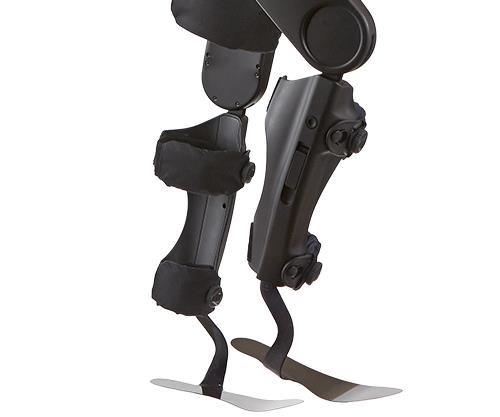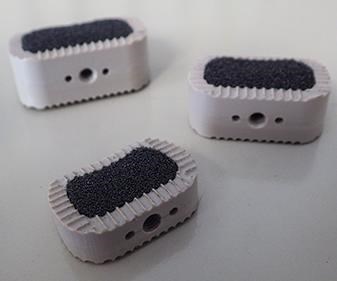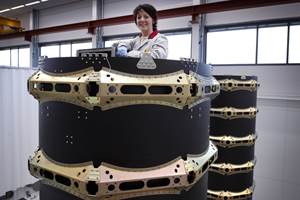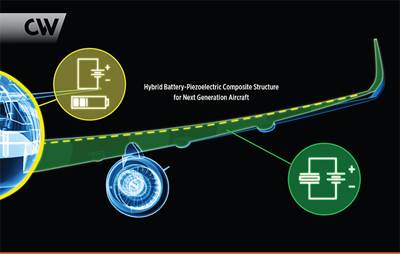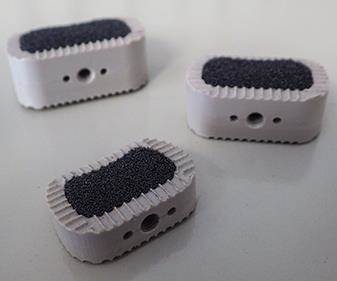CFRP: Opportunities in orthopedics
Carbon fiber has a niche, but can it secure a larger piece of a high-growth pie?
Orthopedics is the branch of medicine that addresses impairments of the skeletal system, ligaments and muscles. It comprises prosthetics — devices that substitute for a limb or joint — and orthotics, such as lower back supports and knee braces, which compensate, assist or stabilize a body part.
Blade-like lower-leg-and-foot prosthetics like those worn by double-amputee Oscar Pistorius when he ran the 100m dash in 11.04 seconds (the current world record is 9.58 seconds, held by non-amputee Usain Bolt) put carbon fiber-reinforced polymer (CFRP) under the spotlight in the Paralympic, Olympic and medical worlds. But strong showings in the sports media have not necessarily mirrored market realities in the medical arena.
For lower-limb prosthetics, CFRP is a very good candidate. “If you look at the feet, they act like a spring,” explains Maximilian Segl, head of composite development at the world’s largest prosthetics manufacturer, Ottobock (Duderstadt, Germany). “The best springs are made with titanium or special steels, but CFRP is lightweight, strong and has especially good fatigue resistance.”
But composites’ place in the wider orthopedics market is not a given. As bionics and other human augmentation devices continue to be developed, manufacturers are looking for lightweight components, but at a lower cost and a greater ease of processing not typical, historically, with composites. There also is a push, particularly in the burgeoning orthotics exoskeleton market, toward less bulky “soft” devices that rely on textiles instead of hard molded components.
That said, opportunities abound where composites’ high performance and low weight justify cost.
Making the most of lower-limb mobility
“Composites and carbon fiber will continue to help us improve people’s mobility,” says Christophe Lecomte, R&D engineer at Össur (Reykjavik, Iceland), which manufactures the Flex-Foot Cheetah and a range of other, mostly lower-limb, orthopedic products.
Due to increased load-bearing and lightweight requirements, CFRP is most common in lower limb prosthetics and orthotics. “Carbon fiber has different, unmatched properties to other materials,” say Lecomte. “For example, in Össur’s CTi Knee brace, carbon fiber is used on the frame, where its high stiffness and low weight secure the knee joint during sport activities. The same material is used in our Flex-Foot prosthetic feet, however, because the outstanding load capability and fatigue properties allow shock absorption and return energy to the user.” He also notes the material’s tolerance to high deformations, amazing versatility and ability to tailor stiffness and strength by adjusting layup schedules.
Össur uses primarily epoxy prepreg, with a range of fibers depending on the device and intended use. Production is highly automated. Össur developed its own tape laying machine to achieve high efficiency in low-void laminates, which are then vacuum-bagged and autoclaved. Cured parts are post-processed using waterjet cutting, CNC machining and robotic grinding. They are incorporated into prosthetic assemblies using structural adhesives and bolts.
CFRP has helped Össur consistently push the boundaries of prosthesis performance. “We found an innovative way to combine several carbon fiber blades in our new Pro-Flex prosthetic foot, which has increased ankle range of motion and peak ankle power,” notes Lecomte.
Selective stiffness in sockets
A promising area of prosthetics is the socket, the part of a prosthesis into which the stump of the remaining limb fits. Most, today, are made from plastic, which is cheap, fairly lightweight and easy to clean. However, demand for ever greater increases in device performance and wearer comfort and capability has opened the door for fiber reinforcement.
“This part is directly on the person, so lightweight is good,” says Ottobock’s Segl, who explains that sockets are somewhat different from other prosthetic applications. “Some areas must be thicker and some thinner. The front side typically includes more flexible zones, so it is not too stiff when walking. But you need stability on the sides.” He notes that some areas of the stump are stronger, with bones underneath the skin, while others are not so reinforced. “You must look at the shape and composition of the stump, and also where the forces are acting as the person moves.”
Segl says that socket constructions in the industry are no longer simply braided fabric impregnated with resin and then cured over a mold. “There are new constructions,” he explains. “They are not round, but now have sections that are stiff and sections that are flexible. They also use very flexible materials between the stiff sections, much like a stringer in a wing.” Hand layup acrylic is an older construction, used to give flexibility. “Though not as stiff or strong as an epoxy laminate,” says Segl, “you can design more rounded edges and can also heat locally to form it like a thermoplastic.” Newer constructions use epoxy prepreg cured below 100°C vs. previous systems that required >120°C. Segl notes these new systems enable stiffer and thinner constructions, which results in greater design flexibility
Bionics: Powered prosthetics
Developments in prosthetics have increased rapidly during the past decade. Powered limbs are increasingly common, with motors that can be controlled by muscles in the stump pushing switches, or by electromyography, which uses algorithms to decode electrical signals in natively innervated or surgically reinnervated muscles, combined with data from sensors on the prosthesis to interpret the patient’s intended movements. There are a variety of robotic, multi-dexterous hands commercially available today, including Ottobock’s Michelangelo hand, Touch Bionics’ (Livingston, UK) i-Limb and Steeper Group’s bebionic3 (see photo at left). Notably, none of these uses composites.
“We use a water-transfer printing process to give the bebionic hand the look of carbon fiber,” explains Martin Wallace, mechanical design manager at Steeper Group, noting, “I investigated carbon fiber for some of the components, but had little interest from the suppliers contacted and my early attempts met with cost barriers.” Instead, bebionic products use cast and machined aerospace-grade aluminum, machined stainless steel, bearing brass and engineering polymers, such as acrylonitrile butadiene styrene (ABS), polybutylene terephthalate (PBT) and polyetheretherketone (PEEK) overmolded with thermoplastic elastomers (TPE) — i.e., rubberized polymers like polyolefin blends and thermoplastic polyamides, polyurethanes or copolyesters — as well as conductive TPE to allow the use of touch-screen devices.
“We have attempted to use glass fiber-filled materials for some of our finger components and would like to use them due to cost savings,” says Wallace, “however, we have often found at the prototype stage that the brittleness of the material discounts its use in favor of more durable cast aluminum.” Cost and durability are serious issues. Powered prostheses can cost many tens of thousands of dollars, while the less-advanced average prosthetic device has a lifespan of only three years according to the National Limb Loss Information Center/ Amputee Coalition (Manassas, VA, US). Thus, materials that can increase durability and/or reduce cost have opportunities at varied points along the product spectrum.
In addition to Ottobock’s individualized products (such as the sockets mentioned earlier), it also makes more industrial, standardized parts, which also use CFRP, such as prosthetic feet and very stiff covers for the knee. Its C-Leg above-knee prosthesis uses a microprocessor-controlled knee mechanism to enable a more stable and efficient gait that more closely resembles a natural walking pattern. “For individualized devices made by orthopedic shops, we must look at how they can use the materials even though their processes are not industrial-type production,” explains Segl.
“For industrial parts, we use autoclaves, stamping, pressing and resin transfer molding, with material selection driven by function of the part. For example, the C-Leg cover must be stiff to protect the hydraulics and electronics inside.” In July 2015, Össur unveiled successful demonstrations of mind-controlled lower limb (MCLL) prosthetics, using its implanted myoelectric sensor (IMES) technology. The first two cases include one above-knee amputee using the dynamic Rheo Knee device and one below-knee amputee using the dynamic ProPrio Foot, made with CFRP. Össur has large-scale clinical trials underway, aiming for commercialization in 3-5 years.
Exoskeletons: Robotic orthotics
As bionics technology begins to transform prosthetic manufacturing, a parallel shift in the orthotics paradigm is well on its way. In 2015, Robotics Trends Media (Framingham, MA, US) managing editor Steve Crow reported the robotic exoskeleton market is forecast to reach US$1.8 billion in 2025, up from US$68 million in 2014, with a CAGR of almost 40%. Crow noted that lower-body exoskeletons used as rehabilitation tools or to improve quality of life are the market leaders, but commercial systems that augment human capabilities will have the strongest growth. And in the workplace, demand for these “wearable robots” is predicted to be on par with industrial robots.
The goals here are injury prevention and productivity improvement for tasks that include heavy lifting, extended standing, squatting, bending or walking, with applications that range from construction and agriculture to transportation and healthcare (e.g., nurses lifting patients).
According to ExoskeletonReport.com, there are at least 40 companies working on hard exoskeletons, both powered and unpowered, and more looking into soft exosuits. A few products tout the use of CFRP for lightweighting, but many rely on metals and plastics.
Segl says exoskeletons naturally evolved from orthoses. Do composites have any opportunity here? “The question is whether it is an active or passive system,” he responds. “Active means powered, and the issue is where the power comes from.” Though he acknowledges big steps are being made in energy storage, “If you need an exoskeletal system to climb stairs, you are moving a 60- to 80-kg load upward, and a battery then also adds weight.”
He says that many exoskeletons are now more nearly robotic than orthotic, “but with energy sources gaining in efficiency, you might be able to integrate an active system via a composite with piezo- fibers. For example, look at NASA’s folding systems for satellites. However, they are moving only grams in space and we are moving kilograms acted upon by gravity.”
Ottobock has licensed two patents from Ekso Bionics (Richmond, CA, US), exoskeleton pioneer and partner to the US Army and Lockheed Martin Exoskeleton Technologies (Orlando, FL, US) in developing assistive devices for soldiers and noncombatants, such as shipbuilders.
The INDEGO exoskeleton by Parker Hannifin (Cleveland, OH, US) has been approved by the US Food and Drug Admin. (FDA, Silver Springs, MD, US) for use with spinal cord injury patients. “We use carbon fiber in the foot braces,”says Parker Hannifin director of global communications Aidan Gormley, “but the rest is made from metal and a mix of ABS and polycarbonate plastic.”
INDEGO exoskeletons will initially be supplied to rehabilitation centers, which will manage their use with patients. “The current focus is not lifetime mobility restoration for these patients,” says Gormley, “but instead to achieve significant health benefits and efficiencies during rehabilitation by replacing the current robotic treadmill training, which requires numerous physical therapists/attendants, while the INDEGO only requires one.”
In the same price range as many exoskeleton products, INDEGO costs roughly US$80,000. Gormley says personal lifelong use is a definite goal, but the cost is a factor and work is still needed to document its health benefits and usage outcomes if users are to obtain health insurance reimbursements. Parker Hannifin has started a four-year, multi-center study funded by the US Department of Defense and the Congressionally Directed Medical Research Programs to do just that. Ekso Bionics also has received FDA approval for its Ekso GT product to be used with stroke and spinal cord injury (SCI) patients, while the US Department of Veterans Affairs (VA, Washington, DC, US) has issued a national coverage policy for ReWalk Robotics Inc.’s (Marlborough, MA, US) robotic wearable exoskeletons for qualifying veterans with SCI. Veterans will be evaluated for use of the device, which uses CFRP footplates to support the patient’s weight, while powered hip and knee motion enables the patient to stand upright and walk independently. Training will begin on an outpatient basis and proceed to home or community settings, followed by consideration for procurement of a personal device for long-term use. Although both ReWalk and Parker Hannifin are focused primarily on rehabilitation products, Parker also is pursuing human augmentation products via its investment in and partnership with Freedom Innovations (Irvine, CA, US), which uses CFRP in a number of its standard prosthetic devices and component upgrades. (Read more in "Composites in exosleletons," under "Editor's Picks" at top right.)
Developments for future devices
Segl is hopeful for improved materials. Although he concedes that carbon fibers are now “better performing and more precise,”he contends that they are still merely tweaks of the same basic materials created in the 1970s. “We need to take the next step in order to make the fibers and matrix more connected,” Segl explains. “We need a better interface between the fiber and matrix so that you are able to get the best performance out of the fiber for each part. Then you will be able to build lighter weight and thinner parts with the same mechanical performance.” Segl also sees a need for tighter production tolerances. He explains that with thermoset composites, “you’re making the material and the part at the same time, so you must have very tight control on the temperature, pressure, viscosity, etc. Variability causes part performance to go down. Simulation of composites is also not as good as with a metal part, which is very exact with standardized material performance data sheets. Our computer simulation is getting closer and closer to actual part performance. If you can improve simulation, you reach the right part design much faster.”
Lecomte says Össur expects its future devices to provide more information to the patients and allow patients to interact with their prostheses. Like Segl, he suggests that next-generation composites could use piezoelectric fibers, for example, as layers in laminates that harvest energy while patients walk to recharge prosthesis batteries. Next-generation composites also could adjust device stiffness on-the-fly in response to in-use conditions or even self-heal in case of damage. (Read more online about multifunctional composites capable of energy harvest and self-healing in “Aerocomposites: The move to multifunctionality,” under "Editor's P
“Our goal is to design prostheses that are closer to the human leg,” says Lecomte. “There is still a lot to do to achieve this goal. Human limbs are complex systems that adapt to the environment and situation.” He says that current bionic prostheses collect data via sensors and adjust behavior with motors. “Our next challenges are to reduce prosthesis weight and volume and efficiently detect and communicate user intent.”
“We expect further developments in resin and fibers in the coming years, which will lead to the design of new, lighter and stronger orthotics and prosthetics,” says Lecomte. Össur is also looking at means to reduce material usage, waste and, possibly, recycling. “There is a need to make the industry more sustainable.”
Related Content
Materials & Processes: Fibers for composites
The structural properties of composite materials are derived primarily from the fiber reinforcement. Fiber types, their manufacture, their uses and the end-market applications in which they find most use are described.
Read MoreMaterials & Processes: Resin matrices for composites
The matrix binds the fiber reinforcement, gives the composite component its shape and determines its surface quality. A composite matrix may be a polymer, ceramic, metal or carbon. Here’s a guide to selection.
Read MoreComposite resins price change report
CW’s running summary of resin price change announcements from major material suppliers that serve the composites manufacturing industry.
Read MoreRUAG rebrands as Beyond Gravity, boosts CFRP satellite dispenser capacity
NEW smart factory in Linköping will double production and use sensors, data analytics for real-time quality control — CW talks with Holger Wentscher, Beyond Gravity’s head of launcher programs.
Read MoreRead Next
Composites in exoskeletons
Wearable robotics need strength, stiffness and lightweight and are forecast at a CAGR of 40-50%. Will composites play a role or be left behind?
Read MoreAerocomposites: The move to multifunctionality
Designers envision aircraft components that do more than bear structural loads, but must first confront great complexities to actualize greater functional efficiency.
Read MoreOrthopedics: Carbon foam fosters bone growth
The Center of Innovation for Biomaterials in Orthopedic Research (CIBOR) at the National Institute for Aviation Research (Wichita, KS, US) has two patents on the use of carbon foam as a bone-graft material to improve success in orthopedic implants.
Read More


